Museum


Belleek Pottery museum endevours to tell the story of Belleek Pottery through its many products made over its 165 year history. Each of the cabinets and displays takes one through the design and production story of Belleek Pottery. Many of the pieces in the museum have been donated by collectors and other owners who wished to allow the many visitors to the pottery to see and appreciate the many wonderful creations crafted and made down through the years.
The Beginnings (Display 1)
In 1853 John Caldwell Bloomfield, owner of the Castlecaldwell estate, commissioned a mineral survey of his lands. It discovered that in an area approximately eight miles from Belleek at Larkhill, there were sufficient deposits of Feldspar and Kaolin (china clay) to make mining commercially viable.
A crushing mill was built at Belleek on the site of an old corn mill and where there was waterpower from the River Erne to drive the machinery necessary to process the raw materials.
These materials were exported to England and a large contract was established with the firm of Kerr & Binns of Worcester, later to become Royal Worcester. James Kerr’s father’s shop in Capel Street, Dublin is where John Caldwell Bloomfield and Robert Armstrong first met and discussed the viability of the project

Display 1
It was through this link that John Caldwell Bloomfield, Robert Williams Armstrong and later David Mc Birney met. Each of them was to contribute vital elements to the foundation and success of the Pottery- land, expertise and finance. The resulting company was known as David Mc Birney & Co. In 1858 construction of the main pottery building started. It is difficult to say exactly when production began but by 1863 making of utilitarian and probably some sanitary ware had commenced.
In the Dublin Exhibition of 1864 the products shown by Belleek consisted of earthen and stoneware in “dinner, toilet and other table services” made by moulding, press and die, or pressure from powdered clay. (Royal Dublin Society, Official Catalogue of the Exhibition of Manufacturers, Machinery and Fine Arts 1864)
The following year they increased the size of their exhibit and at this show they won their first Gold medal.
The McBirney & Co. descriptive entry in the 1865 Dublin Exhibition

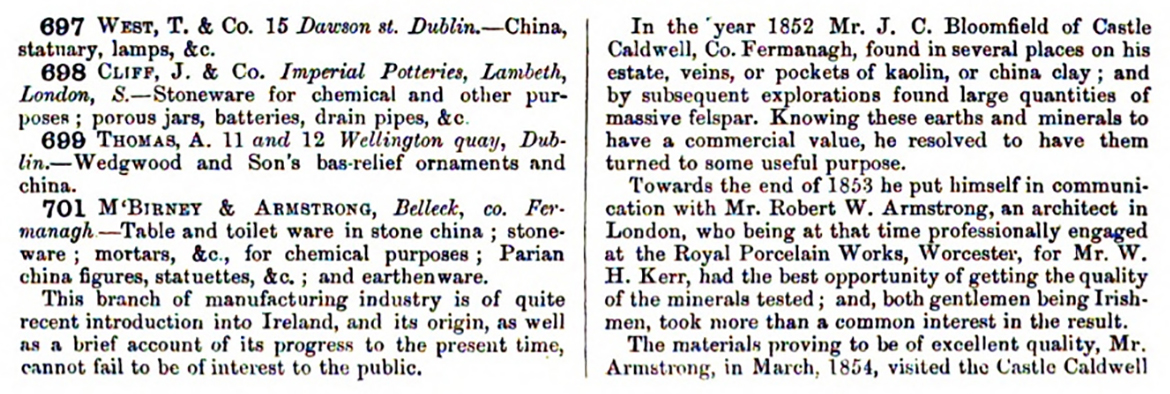
To read the full article in the 1865 Exhibition Catalogue, follow the link:
McBirney & Co Descriptive entry in the1865 Dublin Exhibition
Featured item- Hunting Bowl scenes

Farming in 19th Century Ireland was the occupation of the majority of the population and Belleek catered for this market with a range of in-expensive everyday wares. .These products were only listed as shapes in price lists but could be purchased in a range of patterns and cost from plain to sponge decorated, to transfer printed.
To read more click on this link:
Domestic & Sanitary Ware (Display 2)

From the beginning Belleek produced a wide range of domestic and toiletry wares. These ranged from expensive decorated ewers such as the Etruscan Ewer, shown below right, to the simple colour transfer printed Eldon Ewer & Basin, shown in front. As well, Belleek offered a range of products for everyday use; hospitals and asylums were supplied with items such as bedpans, feeding cups and slop pans. Creameries and milking parlours could obtain milk pans and bowls. Domestic Kitchens with pudding bowls, baking dishes and jelly cans.
Earthenware was the mainstay of the Pottery’s early years and on a roll of one hundred and twenty-five employees in 1897, forty-four were Potters (earthenware), eight Parian makers and ten Basket and Flower makers.
Display 2
Production of heavy sanitary ware began in the early 1870’s.The wealthy were fitting “water closets” into their homes and for a number of years this proved to be a very lucrative market. R. W. Armstrong patented many of the Belleek sanitary ware designs and the design patent of the washbasin shown below was registered on the 28th July 1879.
By the late 1890’s the manufacture of heavy sanitary ware ceased due to technical difficulties and the cost of manufacturing.
Featured item- Decorative Wash basin

It surprises most visitors to Belleek Pottery that Belleek manufactured heavy sanitary wares. It is likely that manufacturing began in the late 1870s and was discontinued sometime before 1900.
This particular wash basin has a registry mark dating it being registered at the Patents Office in London on the 28th July 1879.
To find out more about the story of Belleek Heavy sanitary wares click on the link:
Earthenware (Display 3)
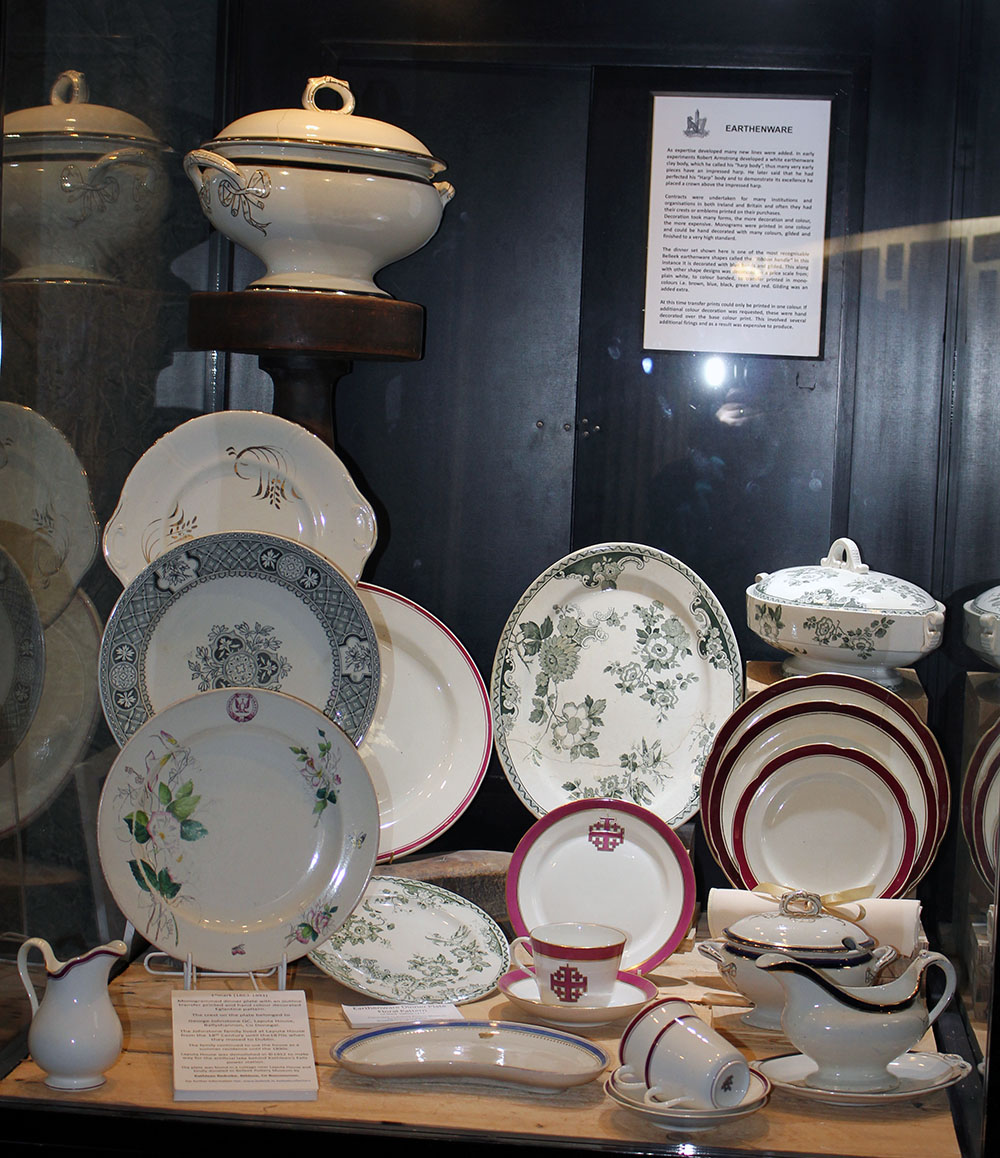
Display 3
As expertise developed many new lines were added. In early experiments Robert Armstrong developed a white earthenware clay body, which he called his “harp body”, thus many very early pieces have an impressed harp. He later said that he had perfected his “Harp” body and to demonstrate its excellence he placed a crown above the impressed harp.
Contracts were undertaken for many institutions and organisations in both Ireland and Britain and often they had their crests or emblems printed on their purchases.
Decoration took many forms, the more decoration and colour, the more expensive. Monograms were printed in one colour and could be hand decorated with many colours, gilded and finished to a very high standard.
The dinner set shown here is one of the most recognisable Belleek earthenware shapes called the “Ribbon handle” In this instance it is decorated with blue bands and gilded. This along with other shape designs was decorated on a price scale from; plain white, to colour banded, to transfer printed in mono-colours i.e. brown, blue, black, green and red. Gilding was an added extra.
At this time transfer prints could only be printed in one colour. If additional colour decoration was requested, these were hand decorated over the base colour print. This involved several additional firings and as a result was expensive to produce.
Featured Item- First Mark Earthenware Plate with a Family Crest
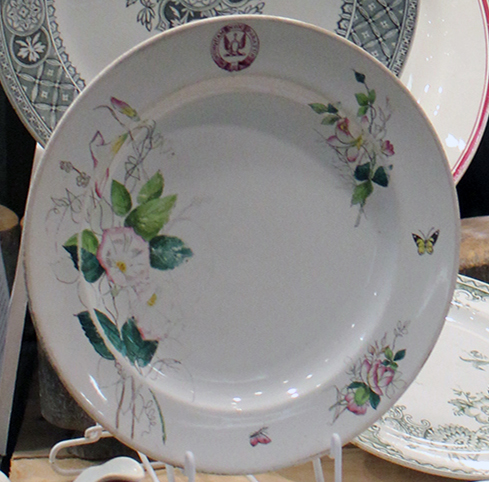
The saying goes “Every picture tells a story” in this instance it’s a plate that will tell us this story.
The plate is earthenware with a first mark and a wild rose printed decoration hand tinted in colour. On the top edge of the plate is a crest, which had the Latin motto “Nunquam non Partis” printed on a banner. The plate has a first black mark and impressed Harp and Crown mark, indicating that it was made sometime between 1863 and 1884 during the tenure of the first Belleek company David McBirney & Co. It would have formed part of a complete dinner set.
To read more about this story- click on this link:
The Dublin Exhibition 1872 (Display 4)
The Exhibition of Arts, Industries and Manufactures organised by Sir Edward Lee were held in Dublin in 1872. The firm of David McBirney & Co. featured Porcelain for the first time.
The list included nine Parian statuettes and busts, twenty-nine different Dessert pieces, sixteen types of table ornaments the latter category including hand woven baskets. Also displayed were thirty-six pattern plates and twenty-four hollow pieces in the dinnerware section. Examples of the Echinus Eggshell Dejuener sets similar to the one purchased by Queen Victoria as well as the Chinese double spouted kettles and tea urns were also on display.
Also exhibited were Earthenware Dinnerware, Tea & breakfast ware, Toilet ware and heavy utilitarian pieces.
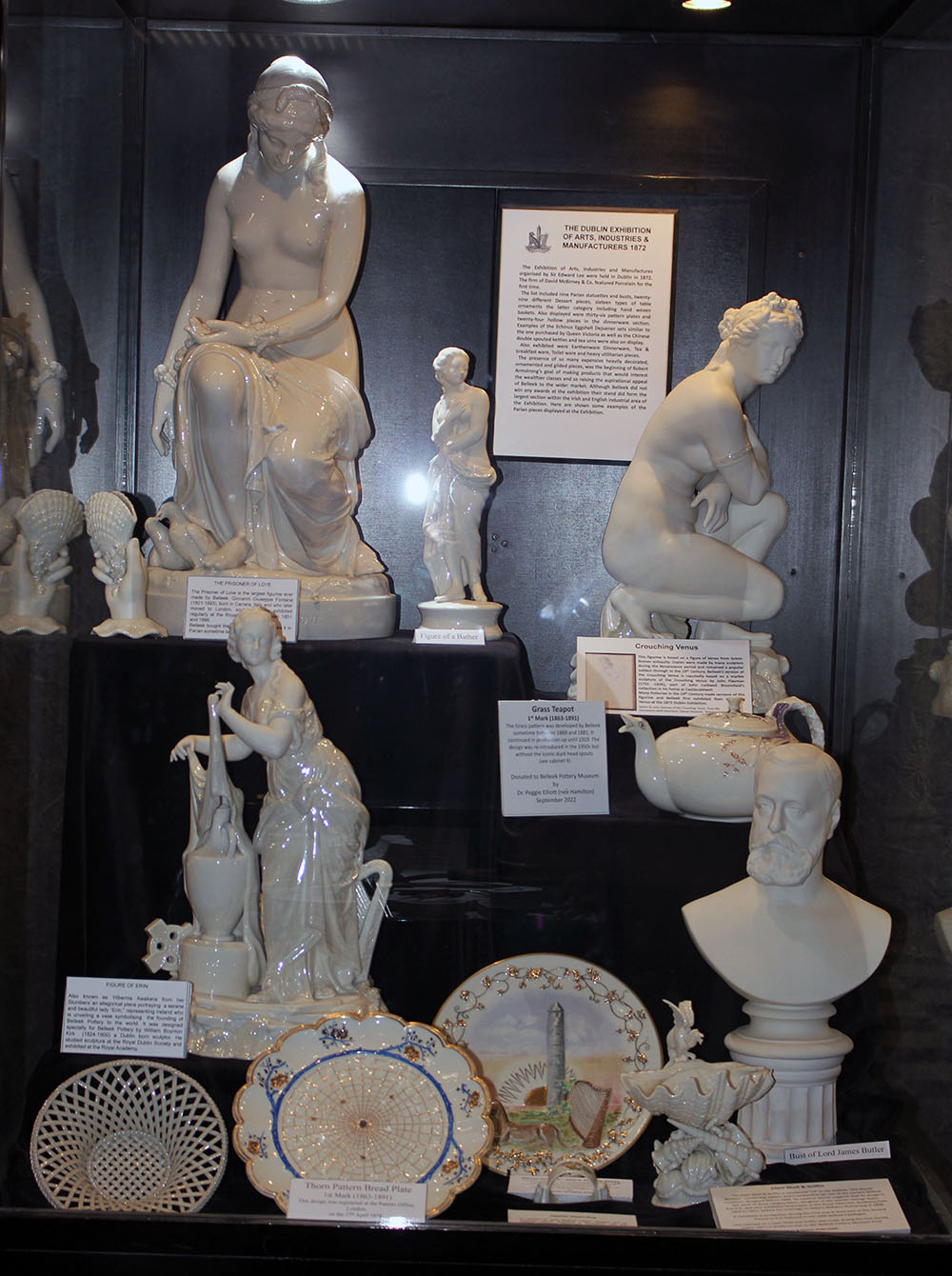
Display 4
The presence of so many expensive heavily decorated, ornamented and gilded pieces, was the beginning of Robert Armstrong’s goal of making products that would interest the wealthier classes and so raising the aspirational appeal of Belleek to the wider market.
Although Belleek did not win any awards at the exhibition their stand did form the largest section within the Irish and English industrial area of the Exhibition. Here are shown some examples of the Parian pieces displayed at the Exhibition.
Featured Item – Figure of Erin
“Erin unveiling her first Ceramic production. The base of the figure represents the flagstones of the fall on which the Pottery is built and from which the town and the products of the Pottery derive their name.”
This is how the figure was described in a Belleek Catalogue published in 1928. William Boynton Kirk (1824-1900) a Dublin born sculptor designed and sculpted this wonderful allegorical piece for Belleek in the late1860.
Here we tell the story of the first time Erin was exhibited at the Dublin Exhibition of 1872.
To find out more click on the link:

Paris Exposition 1900 (Display 5)

Display 5
The elaborately flowered mirror displayed here is believed to be the same as the one sent to Paris for the 1900 exhibition. A similar styled mirror was presented to Queen Victoria on the occasion of her Diamond Jubilee in 1897.
The “Exposition Universelle” of 1900 was a world fair held in Paris, France,
“to celebrate the achievements of the past century and to accelerate development into the next”.
More than 50 million people attended the exhibition (a world record at the time), yet it still failed to turn a profit, costing the French government 2,000,000 Francs. The fair included more than 76,000 exhibitors and covered 1.12 square kilometres of Paris. The exhibition lasted from the 14th April until 10th November 1900.
Belleek won their fourth gold medal at this Exhibition for the International Centre-piece and it is displayed in the foyer of the Visitors Centre.
In the cabinet are shown some of the other exhibits brought to the Paris Exhibition. Some of these, such as the Dolphin Candlestick were in production for many years but others including the Henshall basket, were probably first introduced in Paris.
Featured item: The International Centrepiece

International Centrepiece
Belleek Pottery was represented at the Paris Exposition displaying a number of products including a flowered mirror, flowered table centres and numerous baskets and flowered pedestal pots. However, the crowning piece was the International Centrepiece, a magnificent vase standing over 30” high with pierced details and decorated with an array of hand applied flowers. The vase stands on a pedestal, with three Irish Wolfhounds linked, as if guarding the centrepiece.
To find out more about the International Centrepiece seen in the foyer of Belleek Visitor’s Centre click on the link:
Featured Item Flowered Mirrors/Picture Frames

Flowered mirrors or picture frames were a relatively late introduction into the Belleek design portfolio and the earliest examples are shown in the 1881 “Belleek Old Photograph Album”
To discover more about Belleek flowered frames click on this link:
1904 Belleek Catalogue (Display 6)
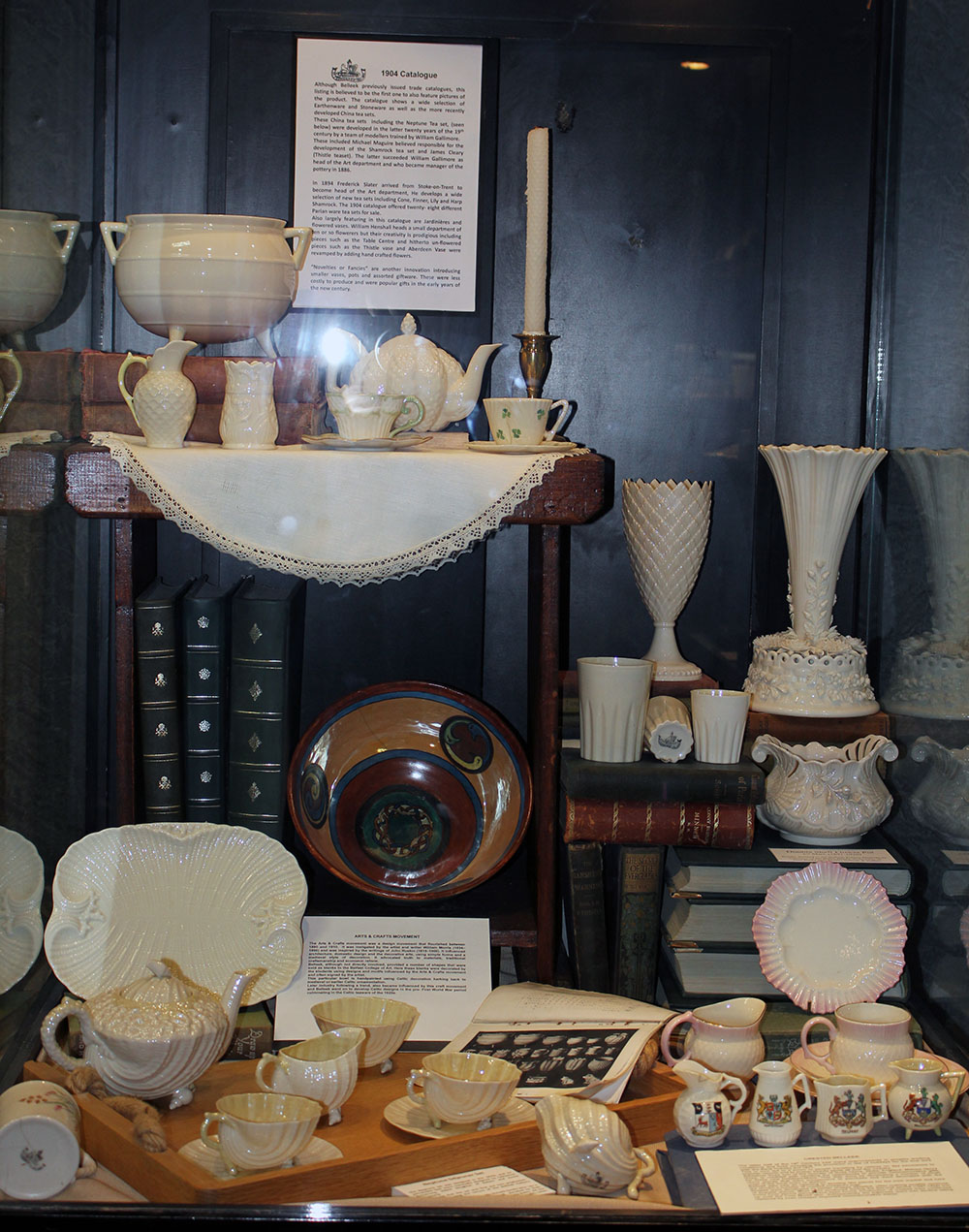
Although Belleek previously issued trade catalogues, this listing is believed to be the first one to also feature pictures of the product. The catalogue shows a wide selection of Earthenware and Stoneware as well as the more recently developed China tea sets.
These China tea sets including the Neptune Tea set, (seen below) were developed in the latter twenty years of the 19th century by a team of modellers trained by William Gallimore.
These included Michael Maguire believed responsible for the development of the Shamrock tea set and James Cleary (Thistle teaset). The latter succeeded William Gallimore as head of the Art department and who became manager of the pottery in 1886.
Display 6
In 1894 Frederick Slater arrived from Stoke-on-Trent to become head of the Art department, He develops a wide selection of new tea sets including Cone, Finner, Lily and Harp Shamrock. The 1904 catalogue offered twenty- eight different Parian ware tea sets for sale.As well, largely featuring in this catalogue are Jardinières and flowered vases.
William Henshall heads a small department of ten or so flowerers but their creativity is prodigious including pieces such as the Table Centre and hitherto un-flowered pieces such as the Thistle vase and Aberdeen Vase were revamped by adding hand crafted flowers.
“Novelties or Fancies” are another innovation introducing smaller vases, pots and assorted giftware. These were less costly to produce and were popular gifts in the early years of the new century.
1928 Catalogue (Display 7)
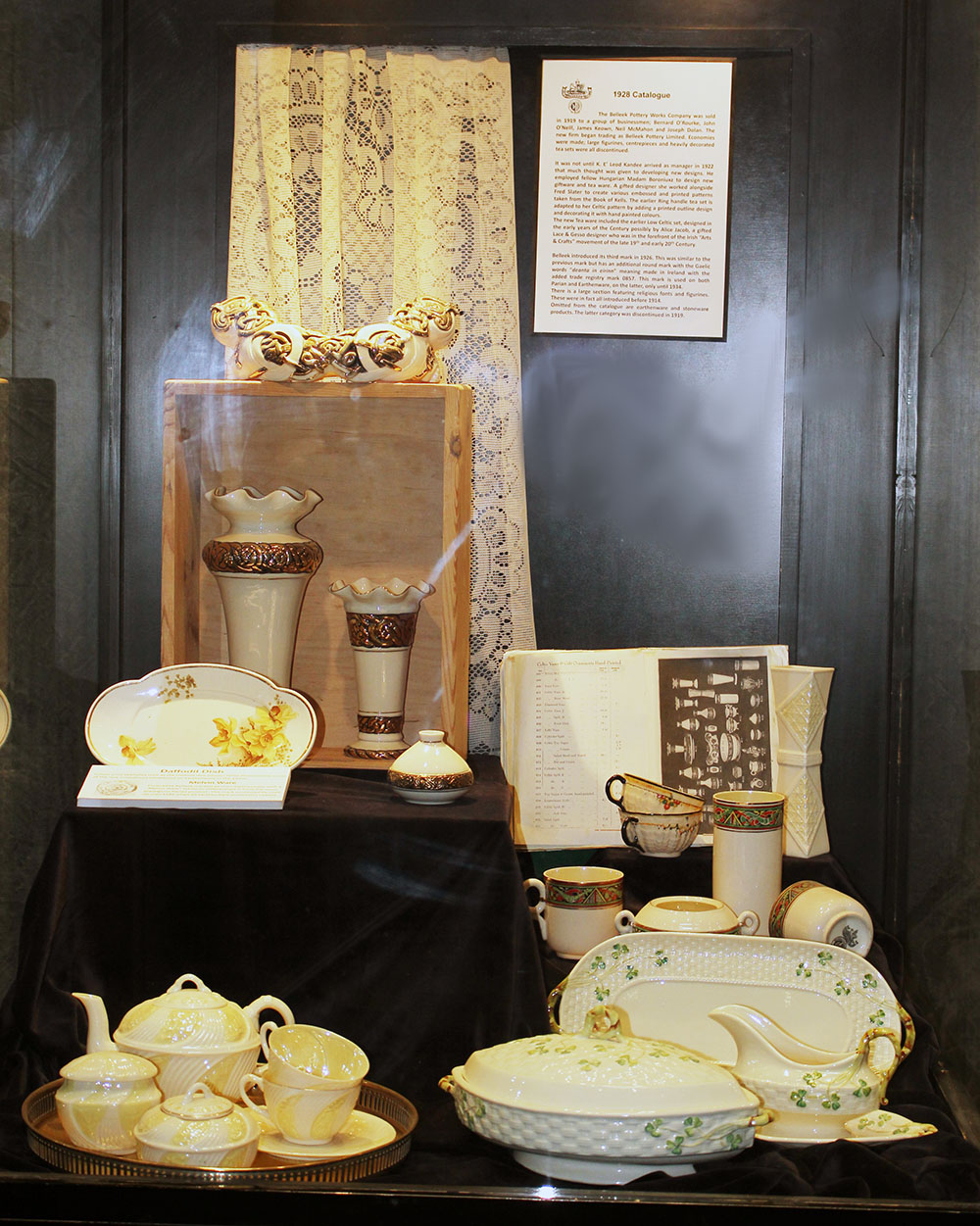
Display 7
The Belleek Pottery Works Company was sold in 1919 to a group of businessmen; Bernard O’Rourke, John O’Neill, James Keown, Neil McMahon and Joseph Dolan. The new firm began trading as Belleek Pottery Limited. Economies were made; large figurines, centrepieces and heavily decorated tea sets were all discontinued.
It was not until K. E’ Leod Kandee arrived as manager in 1922 that much thought was given to developing new designs. He employed fellow Hungarian Madam Boroniuxz to design new giftware and tea ware. A gifted designer she worked alongside Fred Slater to create various embossed and printed patterns taken from the Book of Kells. The earlier Ring handle tea set is adapted to her Celtic pattern by adding a printed outline design and decorating it with hand painted colours.
The new Tea ware included the earlier Low Celtic set, designed in the early years of the Century possibly by Alice Jacob, a gifted Lace & Gesso designer who was in the forefront of the Irish “Arts & Crafts” movement of the late 19th and early 20th Century.
Belleek introduced its third mark in 1926. This was similar to the previous mark but has an additional round mark with the Gaelic words “deanta in eirinn” meaning made in Ireland with the added trade registry mark 0857. This mark is used on both Parian and Earthenware, on the latter, only until 1934.
There is a large section featuring religious fonts and figurines. These were in fact all introduced before 1914.
Omitted from the catalogue are earthenware and stoneware products. The latter category was discontinued in 1919.
1949 Catalogue (Display 8)
The inter war years were a difficult time for Belleek and by the early 1930’s it was thought that the pottery should concentrate on manufacturing earthenware product and cease production of the more expensive baskets and Parian products.
All this changed with the arrival of Harry Arnold as manager in 1933. He had previously worked for Copeland Spode and was definite about continuing China production. Earthenware was trademarked “Melvin ware” so to differentiate it from the more expensive “Parian China ware.” which retained the wolfhound harp and round tower mark.
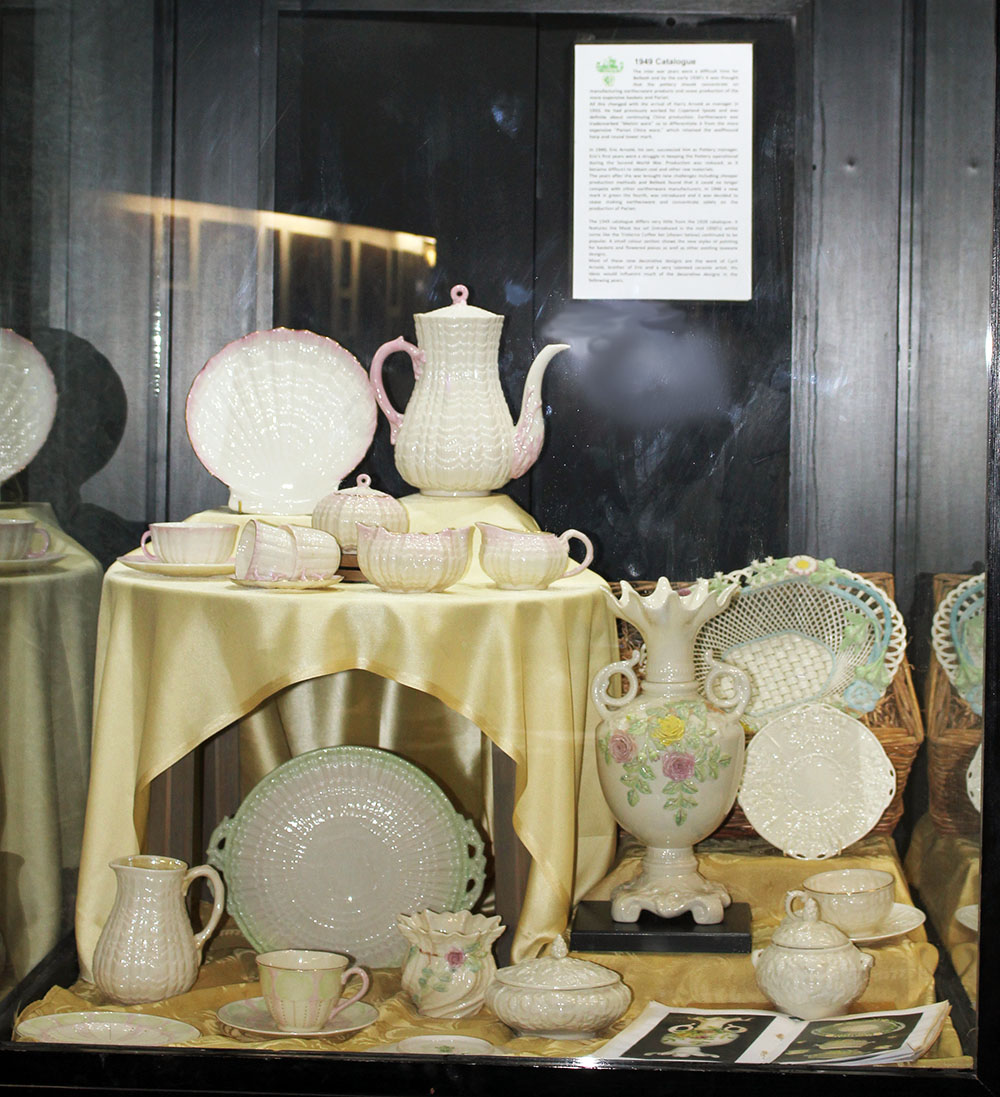
Display 8
In 1940, Eric Arnold, his son, succeeded him as Pottery manager. Eric’s first years were a struggle in keeping the Pottery operational during the Second World War. Production was reduced, as it became difficult to obtain coal and other raw materials.
The years after the war brought new challenges including cheaper production methods and Belleek found that it could no longer compete with other earthenware manufacturers. In 1946 a new mark in green the fourth, was introduced and it was decided to cease making earthenware and concentrate solely on the production of Parian.
The 1949 catalogue differs very little from the 1928 catalogue. It features the Mask tea set (introduced in the mid 1930’s) whilst some like the Tridacna Coffee Set (shown below) continued to be popular. A small colour section shows the new styles of painting for the New Shell, Limpet and other existing teaware designs.
Most of these new decorative designs are the work of Cyril Arnold, brother of Eric and a very talented ceramic artist. His ideas would influence much of the decorative designs in the following years.
1962 Catalogue (Display 9)
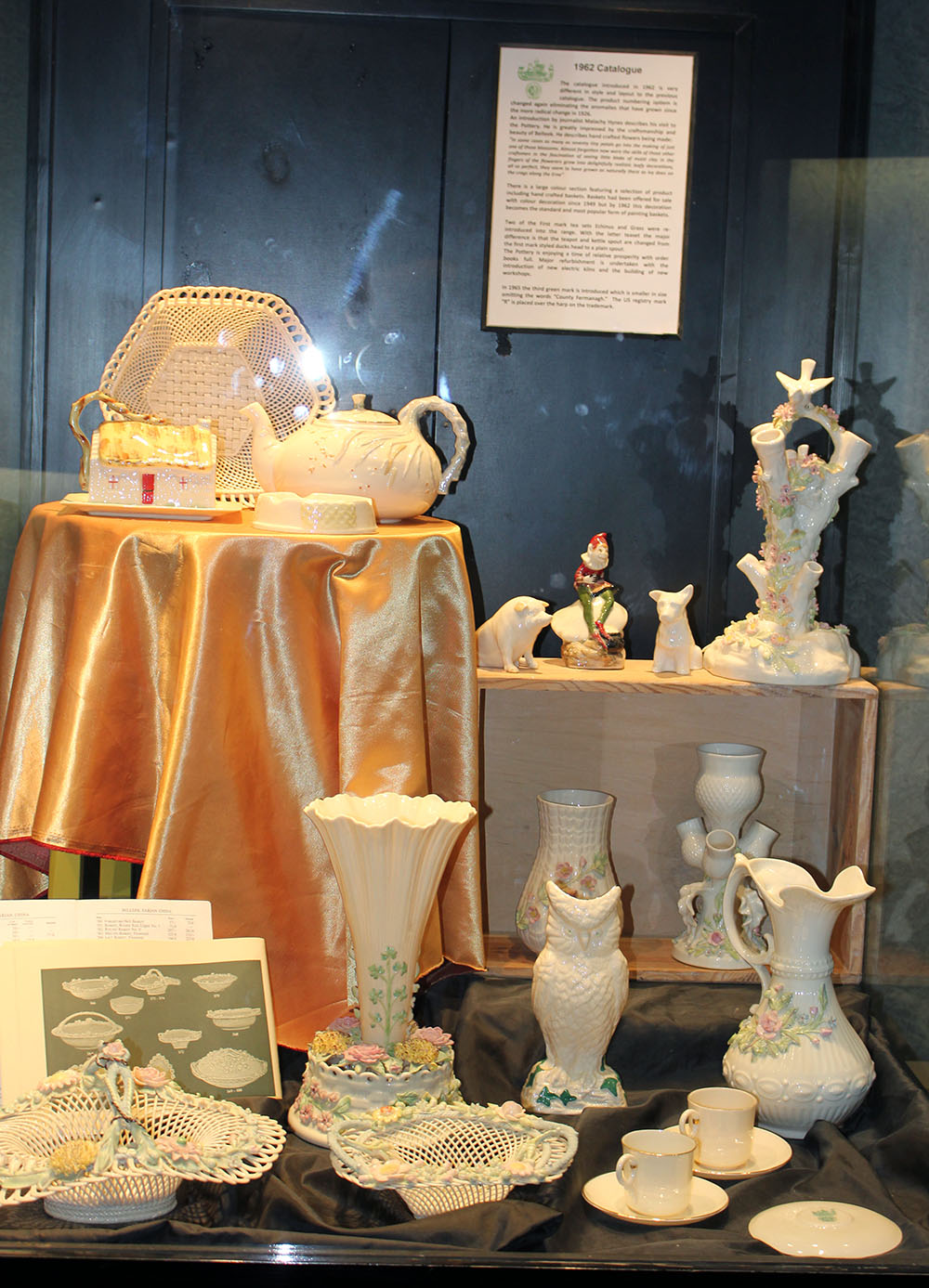
The catalogue introduced in 1962 is very different in style and layout to the previous catalogue. The product numbering system is changed again eliminating the anomalies that have grown since the more radical change in 1926.
An introduction by journalist Malachy Hynes describes his visit to the Pottery. He is greatly impressed by the craftsmanship and beauty of Belleek. He describes hand crafted flowers being made:
“In some cases as many as seventy tiny petals go into the making of just one of those blossoms. Almost forgotten now were the skills of those other craftsmen in the fascination of seeing little blobs of moist clay in the fingers of the flowerers grow into delightfully realistic leafy decorations, all so perfect, they seem to have grown as naturally there as ivy does on the crags along the Erne”
Display 9
There is a large colour section featuring a selection of product including hand crafted baskets. Baskets had been offered for sale with colour decoration since 1949 but by 1962 this decoration becomes the standard and most popular form of painting baskets.
Two of the First mark tea sets Echinus and Grass were re-introduced into the range. With the latter teaset the major difference is that the teapot and kettle spout are changed from the first mark styled ducks head to a plain spout.
The Pottery is enjoying a time of relative prosperity with order books full. Major refurbishment is undertaken with the introduction of new electric kilns and the building of new workshops.
In 1965 the third green mark is introduced which is smaller in size omitting the words “County Fermanagh.” The US registry mark “R” is placed over the harp on the trademark.
1978 Catalogue (Display 10)
This catalogue is in full colour with many pictures of the pieces photographed in home settings. For the first time there is a brief history of the Pottery and a description of the process of making Parian. At this time with the quality of the photography, printing techniques and layout, the catalogue was considered a major step in revamping the image of the Belleek Pottery product range.
The sales of giftware are becoming more important and this is reflected in the reduced number of tea sets. There are six sets remaining, these are; Tridacna, Limpet, New Shell, Neptune, Harp shamrock and Shamrock.
The continuing popularity of Shamrock tea ware is mirrored in the extensive number of pieces featuring in the catalogue.
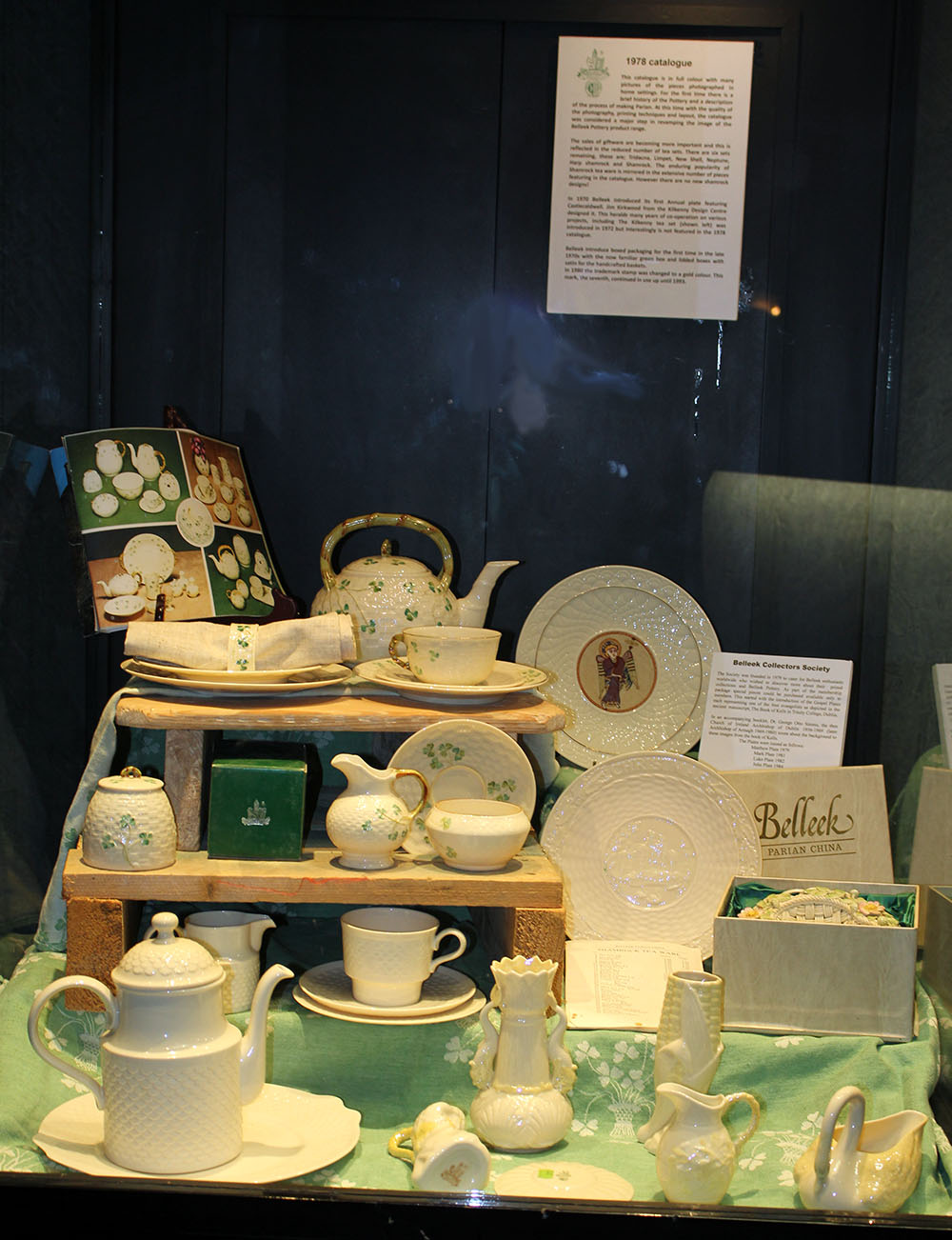
There are no new shamrock designs though this remains the most popular and enduring of all Belleek’s production output.
In 1970 Belleek introduced its first Annual plate featuring Castlecaldwell. Jim Kirkwood from the Kilkenny Design Centre designed it. This heralds many years of co-operation on various projects, including The Kilkenny tea set (shown left) was introduced in 1972 but interestingly is not featured in the 1978 catalogue.
Belleek introduce boxed packaging for the first time in the late 1970s with the now familiar green box and lidded boxes with satin for the handcrafted baskets.
In 1980 the trademark stamp was changed to a gold colour. This mark, the seventh, continued in use up until 1993.
Display 10
The Belleek Visitors Book 1868 – 1884
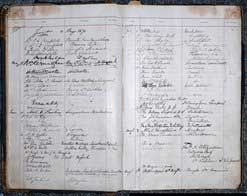
The first entry is dated October 1st 1868 and is signed by the Earl & Countess of Lanesborough of Lanesborough Lodge, Belturbet, Co Cavan.
Captain John Vansittart Danvers Butler, 6th Earl of Lanesborough was born on 18 April 1839. He was the son of Captain Charles Augustus Butler Danvers and Letitia Rudyard Ross Freese. He married Anne Elisabeth Clark daughter of the Reverend John Dixon Clark, on 21 June 1864.
The Earls of Lanesborough were extensive landowners in both Ireland and England and held estates in Co Cavan and Fermanagh. The villages of Newtownbutler in Co Fermanagh and Butlersbridge in Co Cavan are named after the family.
They arrived accompanied by Viscount and Lady Templetown from Castle Upton, Templepatrick Co Antrim.
George Frederick Upton sat as a Conservative MP for Antrim from 1858 to 1863. In 1866 he became an Irish Representative Peer and sat in the House of Lords as Lord Templetown.
We cannot know if the Visitors Book was purchased specially for the visit of these important visitors but the arrival of such well-connected persons would have certainly been considered well worth recording to impress other visitors who in turn would also record their names.
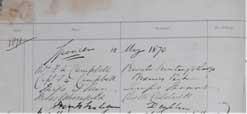
In the weeks and months that followed many other important visitors are noted. Lord and Lady Enniskillen, Miss Brooke of Ashbrooke Co Fermanagh along with Miss Bloomfield daughter of John Caldwell Bloomfield of Castlecaldwell. Late in December 1868 Mr Richardson the High Sheriff of Co Fermanagh also visited the Pottery.
The first visitor from England is Archibald Anson from Longfield Rectory in Derbyshire signed his name in January 1869.
This entry is followed by a long list of persons from the titled aristocracy of the day to the landed gentry to visitors to the locality.
This latter category would increase in volume over the next decade with the popularity of travelling by train on holiday excursions.
The railway connection from Belleek opened in 1866. Another category visiting were returned emigrants who had made good in the New World and were able to travel back across the Atlantic, to visit the land of their birth. These included Rev William McNulty of Passaic, New Jersey visiting Ballyshannon, also Thomas McElderry Sinclair and his wife Caroline of Cedar Falls, Idaho visiting their families in Belfast.
Today we are ever mindful of the potential of tourism and in particular Belleek has been successfully attracting large numbers of visitors over the last twenty-five years with its Visitors centre and factory tour that encompasses every aspect of the making of Belleek fine porcelain. So it is perhaps surprising that the founders of Belleek had already seen the potential of attracting visitors.
The visit of The Earl & Countess of Spencer, the Lord Lieutenant of Ireland and his wife on May 12th 1870 was a remarkable event and it gave the fledgling Pottery an tremendous endorsement by the Viceroy, Queen Victoria’s representative in Ireland. He later placed an order for a dinner service with his family crest and a porcelain tea service of the Echinus pattern also with his family crest.
His visit is recorded by a report printed in the Irish Times.
Can’t wait for your tour? Shop Belleek Online
Sign up to our Mailing List
Keep up to date with the latest news from Belleek Pottery Visitor Centre
